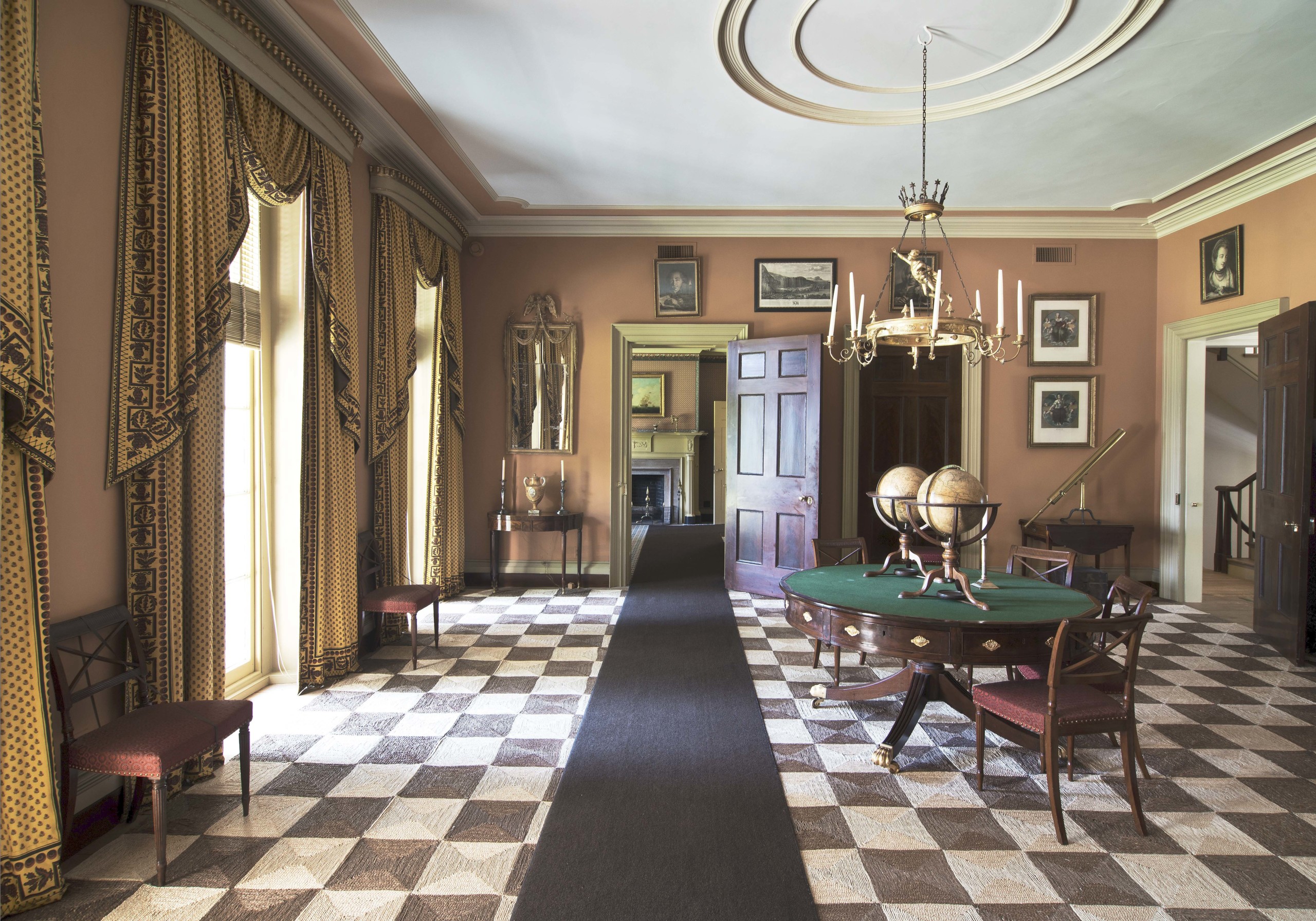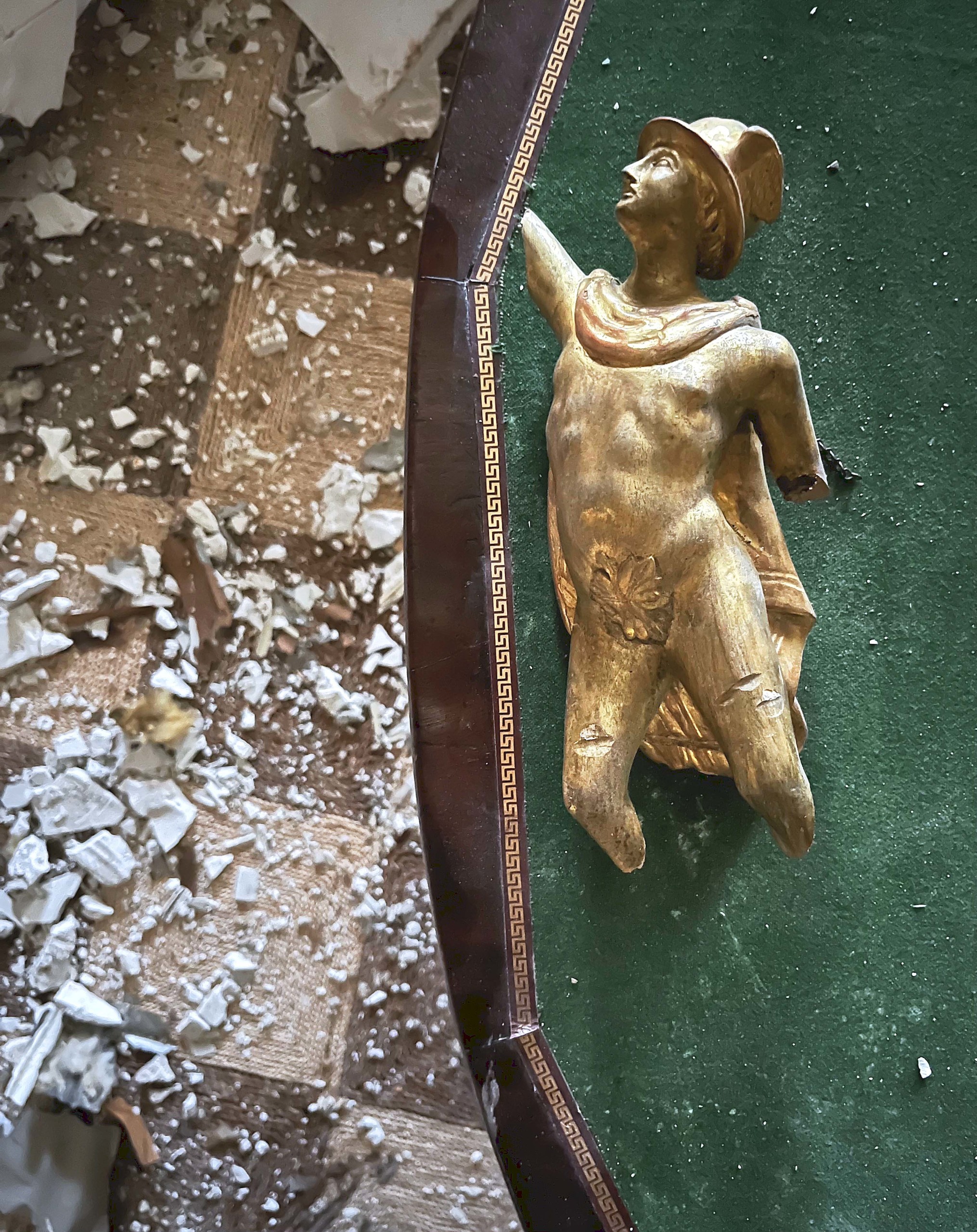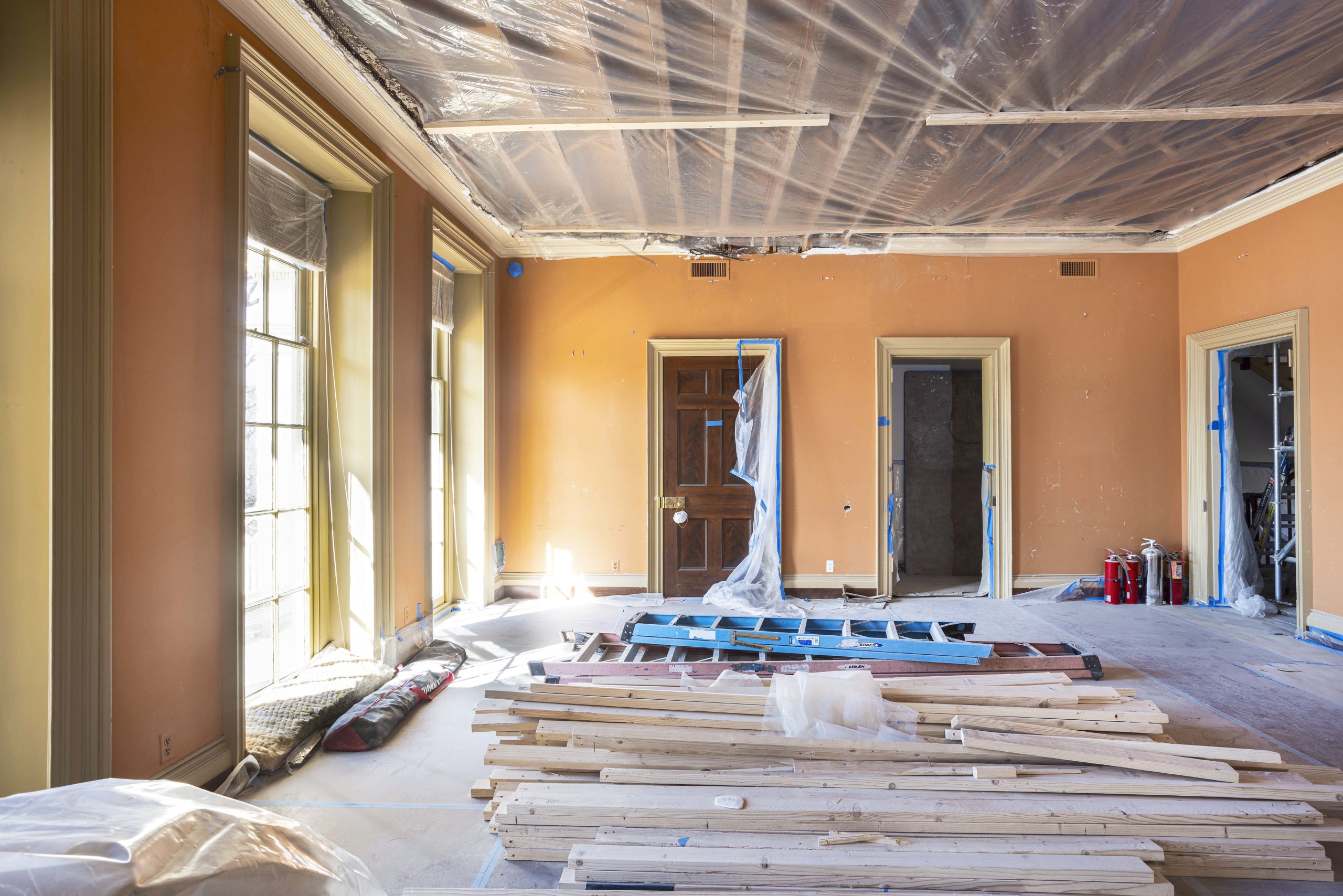
Folks who oversee historic properties dread the prospect of events or accidents that destroy important — and often singular and irreplaceable — works of art or collections. Such a worst-case scenario came to pass in April 2024, when the library ceiling collapsed at Boscobel, a historic circa 1804-08 Federal home in Garrison, N.Y. We reached out to executive director and curator Jennifer Carlquist for an update on what was lost, survived or needed to be repaired, where things stand with the restoration and what the road to recovery looks like for the historic property that overlooks the Hudson River.
For those readers who aren’t aware, what happened about a year ago at Boscobel?
On Tuesday, April 16, 2024, the library ceiling in Boscobel’s Historic House Museum collapsed without warning. Thankfully, no one was injured or in the building at the time — a school group had departed hours earlier. However, the collapse caused catastrophic damage to the room, its contents and adjacent spaces. The forced closure of the museum, and pause of Guided House Tours, our most popular program, has been a hardship for our visitors, staff and the organization.

A photo of the library prior to the collapse of its ceiling.
Can you describe the damage and what needed to be done to restore the house to its original condition?
Heartbreaking. There were miraculous survivals, total losses and everything in between. Elements of three rare landscape chairs were literally pulverized, while their three mates from the same set were saved by being positioned under a game table. A pair of Chinese export urns that curator Berry Tracy had used in the 1970s to inspire the room’s distinctive color were smashed into shreds, but we hope to acquire another pair. The room’s crowning glory, an English chandelier with a gilded Hermès figure, was crushed beyond repair, and I have not yet had the heart to contemplate its replacement.
Beyond the library, every surface and object in the house was coated with plaster dust. In the weeks spent without climate control while the HVAC had to be shut down and cleaned, humidity tarnished silver and adhered plaster dust to wood, wallpaper, elaborate window treatments, carpets and other textiles. It took an army of conservators and museum peers rallied by the Greater Hudson Heritage Network, and boxes donated from local businesses, to deinstall the entire collection and move it to safe storage. Since May, a team trained by Textile Workshops has carefully vacuumed and cleaned more than 250 individual objects and counting. Because every move and construction phase poses risks to objects, we won’t really know the extent of the damage until the construction crews leave; all the dust, scaffolding and protections are removed and every object is returned to its rightful place.
After months of observation and testing, engineers ascertained the collapse’s cause: when Boscobel was reconstructed in the 1950s, the ceilings were made of a concrete-like plaster, applied to a metal lathe, affixed to the joists with nails. Nails ultimately proved insufficient to support the weight. When the 2½-ton ceiling in the library gave way, its impact cracked and loosened ceilings and decorative moldings throughout the building. Engineers determined that 19 of our 24 ceilings must be replaced and that demolition had to begin immediately.
This Phase I emergency restoration will replace the ceilings with their period details intact. It also necessitates upgrades to insulation, electrical, fire and safety alarms, etc. It will not return Boscobel to its “original” appearance, however, because many of our custom-made carpets, curtains, wallcoverings, etc., were also damaged. A complete room-by-room reassessment and refresh will be the focus of Phase II. For nearly 50 years, Boscobel’s period rooms have been lauded as among America’s most beautiful and largely held static. Phase II is a once-in-a-generation opportunity to carry the best of Boscobel’s past forward in a new-furnishings plan also informed by fresh perspectives.

The first photo taken of the library after the ceiling collapsed.
Were there other projects underway before the damage occurred? What are those projects? Have they been delayed or are they continuing in parallel with the restoration work?
Since 2022, Boscobel has made incremental site improvements outlined in a Master Site Plan developed with Reed + Hilderbrand: upgraded site infrastructure, increased ADA access in key areas, building a 5,000-square-foot seasonal Pavilion and planting a native Meadow. Other than routine maintenance, our only major house project was completing installation of an ADA-accessible lift — until gravity took hold.
Years of proactive work prepared us somewhat for this disaster, including Emergency Response training, a textile survey conducted just last January by Amelia Peck, a recently completed IMLS-funded Interpretive Plan that identified future period room revisions and ongoing engagement with the Chipstone Foundation thanks to longtime advisor Peter Kenny.
Our staff and board saddled up to leap over every hurdle, converting our Visitor Center into gallery space for rotations featuring Duncan Phyfe furniture, Thomas Commeraw stoneware, John André’s flute and photographs of Hudson Valley farms by Pieter Estersohn. We hosted the American Folk Art Society and our first-ever Native Meadow symposium with environmental partners. We attracted growing audiences to our annual Chamber Music Festival and launched a Bloomberg Connects guide for mobile devices. This September, we will unveil an ambitious exhibition “Scenic Vistas: Landscape as Culture in Early New York,” with support from the NEA, Terra Foundation and the Decorative Arts Trust.

Boscobel’s damaged Hermès chandelier.
Is it possible to find a silver lining in this accident and think positively about it?
Absolutely. This restoration is opportunity, writ-large. After a decade at Boscobel and three decades in this field, I knew that our historic house museum had the potential to be beautiful, educational and more accessible and dynamic. The collapse empowers us to make space for new traffic patterns and experimentation. In Boscobel’s next chapter, people and ideas will circulate more freely.
Of course, the restoration is an educational opportunity itself. We share restoration and conservation projects via traditional and social media, newsletters and onsite and online programming, and through preservation conferences and publications. Our assistant curator Riley Richards is working on a spring exhibition on building Boscobel in 1808, the 1950s and today. We hope to pay forward the generous assistance provided by our fellow cultural organizations — Greater Hudson Heritage Network, the MET’s American Wing, Smithsonian Cultural Rescue Initiative, Greenwich Historical, Caramoor, Jenrette Foundation, Preservation League of NYS, Putnam History Museum and many others.
Where is Boscobel getting the funding to pay for the repairs? Are you currently fundraising? What does that look like?
This is an existential moment for Boscobel. Insurance coverage is partial at best, and long gone are days when the largess of our founding patron Lila Wallace covered everything. The costs of the Phase I emergency repairs, less insurance received thus far, exceed $1.2 million — and that is before replacing any soft furnishings in the period rooms. Boscobel has been resurrected against all odds on multiple occasions. The house can rise from the dust more vibrant than ever, but only with support from neighbors, connoisseurs and concerned citizens of all kinds.
Morrison Heckscher, former chair of the American Wing at the Metropolitan Museum of Art, is my dearest mentor and a daily advisor on this project. As he so eloquently puts it, “The essence of Boscobel is the house, a unique and altogether wonderful architectural treasure from our Nation’s early days. To forego the opportunity afforded by the recent ceiling collapse to bring this building and its surroundings into the Twenty-First Century would be a tragic loss to the cultural fabric of the Hudson Valley.”
We hope your readers will consider supporting our fundraising efforts. Donations can be made directly via Boscobel.org, by mail to 1601 Route 9d, Garrison, N.Y. 10524, or by contacting us directly.

Mid-restoration photo of the library.
Other than support from the local and greater museum community, what’s the response been from the local public?
Boscobel was restored to feel as though it had always been here, and always would be beautiful and pristine, so shock is most people’s first response. I spoke on a panel at The Winter Show and the audience literally gasped at the scale of the damage and restoration required — it’s a massive undertaking. Around town and in emails and calls from around the country, people ask me about their favorite room or collection object or share a childhood memory of their parents or school bringing them. People have such personal attachments to this place.
You mentioned that Boscobel ‘has been resurrected against all odds on multiple occasions’ — can you elaborate a bit more?
In 1806, States Dyckman died with only the house’s foundation completed, leaving his widow, Elizabeth, to raise their surviving child, oversee the farm and finish and furnish the house with a small corps of relatives and free, newly manumitted and indentured servants. By the 1880s, the estate fell out of family hands and later became a county park. The house was in such disrepair during this time that local boys used to ice skate in the dining room. An April 1946 The Magazine Antiques article cried “Save Boscobel!” when the federal government developed the farm into a hospital for WWII veterans, but in 1955 it was sold to a wrecking company for $35 and dismantled. Concerned citizens saved decorative elements and stored them in barns and garages until Lila Acheson Wallace signed on as the founding patron and resurrected them on our glorious Garrison site. Over its two centuries, Boscobel outlived age, changes in fashion and ownership, flooding, fires, plagues, neglect, war, weather and the wrecking ball. This most recent disaster is the ultimate reminder that Boscobel’s survival has never been inevitable, and it isn’t now. It depends upon the individuals who appreciate history and beauty, feel compelled to share them with future generations and step up to write the next chapter in this story.
—Madelia Hickman Ring




